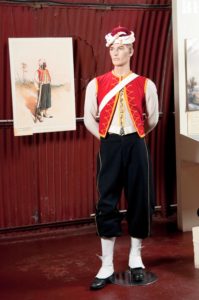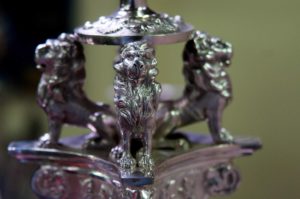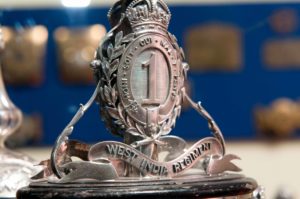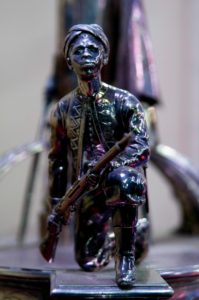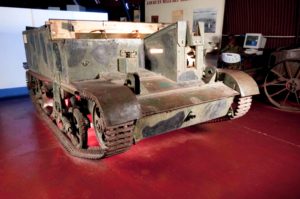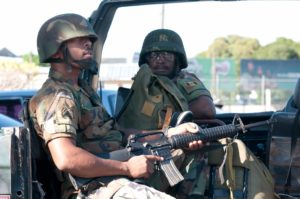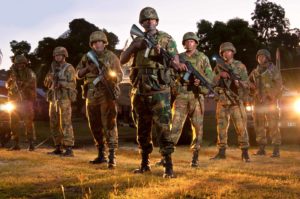Origins
|
History of the JDF The Jamaica Defence Force (JDF) was formed just a few days prior to Jamaica becoming a sovereign independent State within the Commonwealth of Nations. Although the Force itself is still young, it has a long history of descent and traditions stemming from units raised in the West Indies since the mid-seventeenth century.
Early Origins
Its original predecessor was the ancient Jamaica Militia of 1662, the immediate successor to Oliver Cromwell’s troops which had taken Jamaica from the Spaniards a mere seven years earlier. In 1694, in the only invasion of Jamaica other than the English one of 1655, the French landed a force of over 1,400 men at Carlisle Bay in southern Clarendon. Here they were met by militiamen, initially only some 250, who alone – without support from any naval or regular army units – repulsed the French with about 100 men killed or wounded. Estimates of the French losses were between 150 and 350. The various cavalry and infantry regiments of the Jamaica Militia remained on call, at first for fear of further French attacks, although after Carlisle Bay there were none. Therefore, those early part-time soldiers spent most of their time in uniform in an internal security role, which largely meant dealing with slave disturbances. Later, however, with justified fear of Napoleonic incursions, the Militia reached its maximum strength at the beginning of the nineteenth century, with 10,000 infantry and 1,000 cavalry divided between three regiments of horse, one for each county, and 18 regiments of foot, one for each of the then 18 parishes of Jamaica – and commanded at one time by no less than four Major Generals. In 1906, at a time of established international peace, and after nearly two and a half centuries of existence, the Jamaica Militia was finally disbanded. Some of its members formed themselves into the semi-official St Andrew Rifle Corps and when war came to the world in 1914 its members were re-embodied as the Kingston Infantry Volunteers. At the start of World War II in 1939 these part-time soldiers were renamed, this time as the Jamaica Infantry Volunteers (JIV). Towards the end of the war, in 1944, in recognition of its then unit status the JIV was retitled ‘The Jamaica Battalion’, and finally eleven years later – ‘The Jamaica Regiment’.
The West India Regiment and the Birth of the JDF
Troops for the WIR were recruited from freed slaves in North America, slaves purchased in the West Indies and slaves from Africa bought off slave ships. To gauge the strength of the WIR, records tell us that in 1807, the British Parliament freed some 10,000 black slaves who were soldiers in the WIR.
The fact that the WIR was an integral part of the British regular army was unique. Its soldiers fought in the fierce Caribbean campaigns of the Napoleonic wars, in the USA during the War of 1812, and in the 19th century Ashanti wars in West Africa. However, by 1888 only one such regiment remained. In all these campaigns, Jamaicans, probably more than other West Indians, served with distinction.The Victoria Cross Awards to West Indian Servicemen The Victoria Cross is the highest and most rarely awarded gallantry decoration in the British Army. It was instituted by Royal Warrant in 1856. Each May, the JDF hosts a series of commemorative events in honour of two West Indians who, by their exceptional displays of bravery while serving in the WIR, received the Victoria Cross. They are: Lance Corporal Samuel Hodge In 1866 (30 June), Private Samuel Hodge (later Lance Corporal) of the 4th Battalion, The West India Regiment, was the first soldier of African descent (Tortola, Virgin Islands), to be awarded the Victoria Cross, for placing himself in mortal danger to hew down an enemy stockade so his Regiment could take the town in Gambia (West Africa). Hodge died from his injuries in 1868 and is buried at Belize City (then Honduras) Military Cemetery.
Sergeant William James Gordon Disbandment of the West India Regiment In 1888, the two remaining West India Regiments merged into a single regiment, each as a battalion. After fighting in World War One, in 1920, the 2nd Battalion amalgamated with the First Battalion. The Regiment (WIR) was disbanded in 1927, when on 31 January 1927, it paraded for the last time at Up Park Camp. The reason for the disbandment was mainly economic, given that local forces were being raised to protect the colonies. The WIR reformed for a short time between 1958 and 1962. The formation of the Federation of the West Indies in 1958 led to the reconstitution of the West India Regiment. However, the politically unsuccessful Federation was dissolved two months before Jamaica’s Independence on 06 August 1962. Consequently, elements of the recently disbanded West India Regiment were drafted into the core of the new Jamaica Regiment, and 31 July 1962 saw the creation of the Jamaica Defence Force. History of the Jamaica Defence Force The Jamaica Defence Force (JDF) was formed on 31 July 1962 with the West India Regiment – disbanded just the day before – providing the nucleus. On formation, the Force comprised two regular units ‘Headquarters and Support Units’ (colloquially known as "Staff and Services"), and the First Battalion The Jamaica Regiment (1JR), as well as the Jamaica National Reserve, at that time comprising one infantry battalion. The Third Battalion The Jamaica Regiment (3JR(NR)), which was formed in 1961 as the then sole component of the Jamaica National Reserve, became a part of the Jamaica Defence Force on 31 July 1962. Headquarters and Support Units comprised the Force Headquarters, the Garrison Administrative Unit, the Jamaica Military Stores Depot, the Jamaica Military Workshop, the Military Estates Office and the Jamaica Military Pay and Records Office. In 1963 the Jamaica Air Wing, the Jamaica Sea Squadron and the Force Engineer Unit (incorporating the Military Estates Office) were formed as sub-units of Headquarters and Support Units. The Jamaica Military Band (the band of the original West India Regiment of 1795 which, following the Regiment’s disbanding, had been renamed ‘Jamaica Military Band’ in 1927 with semi-military status) had become a purely civilian unit in 1959 as a corporate body under the Ministry of Home Affairs. It now became a part of the Jamaica Defence Force with the advent of Independence in 1962. |
|
||||||||||||||||||

